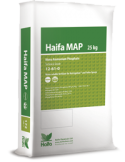Monoammonium phosphate cheaper

The residual hydrochloric acid remaining after the production of potassium nitrate (see: Potassium nitrate from the Dead Sea) is used to produce monoammonium phosphate (NH4H2PO4). The basis for this production process is rock phosphate that is obtained from the Negev desert. The hydrochloric acid is passed over the rock, resulting in the formation of phosphoric acid. That phosphoric acid is then caused to react with ammonium, which leads to the formation of monoammonium phosphate.
The residual hydrochloric acid remaining after the production of potassium nitrate (see: Potassium nitrate from the Dead Sea) is used to produce monoammonium phosphate (NH4H2PO4). The basis for this production process is rock phosphate that is obtained from the Negev desert. The hydrochloric acid is passed over the rock, resulting in the formation of phosphoric acid. That phosphoric acid is then caused to react with ammonium, which leads to the formation of monoammonium phosphate.
In the Netherlands, monoammonium phosphate is still used on a fairly small scale. Here, more use is currently made of ammonium nitrate (NH4NO3). That’s actually quite strange, because monoammonium phosphate is cheaper to use in fertilisation programmes. This solid fertiliser is moreover easier to dose than the liquid ammonium nitrate. It’s easier to pour 10 kilos of solid fertiliser into a container of water than to empty a jerrycan into it. The latter moreover often involves splashing and mess.
The phosphate contained in the monoammonium phosphate promotes root development and gives plants a good colour. The ammonium is important for regulating the plants’ growth. It ensures that the pH remains low enough for the plants to be able to continue to take up all the elements they need.
Plants always need some ammonium. Around 15 to 20 years ago, blossom-end rot caused a lot of problems in tomatoes. Research carried out at the time showed that the risk of blossom-end rot was increased by high ammonium values. In attempts to solve this, growers gave their crops calcium nitrate without ammonium. This indeed solved the problem of the blossom-end rot, but it also led to major problems concerning the uptake of trace elements and phosphate. So excess ammonium involves a risk of blossom-end rot, but plants nevertheless do need some ammonium.

